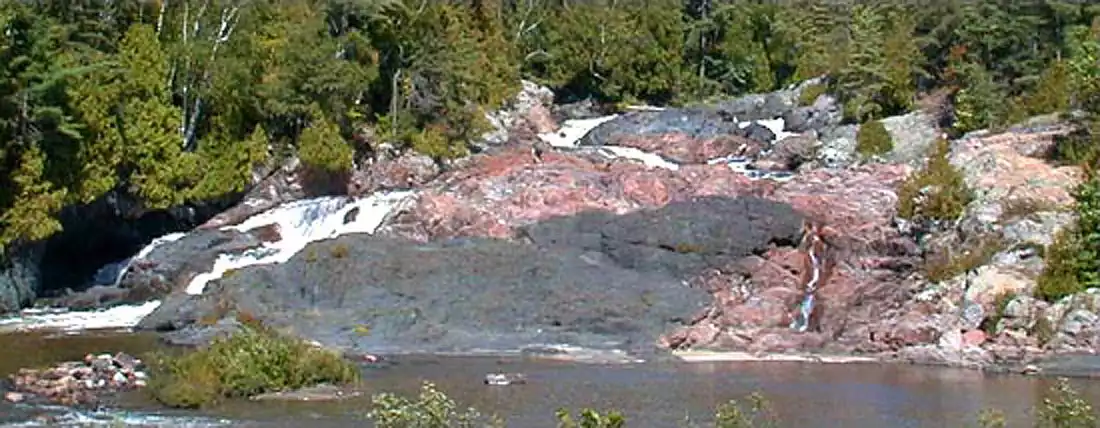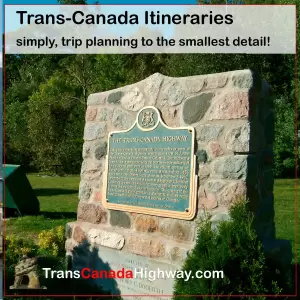What to See & Do in on the Main Canada-Canada Route?
The Main Route of the Trans-Canada goes from Victoria on Vancouver Island, through the scenic Rockies, across the wide open Prairies, and then cuts across Ontario’s rugged Canadian Shield before hitting the St Lawrence and Atlantic Lowlands. from there it side-tracks across the red sandy soils of PEI, the northern extremes of the Appalachians in Cape Breton, and then again after a ferry ride crosses the rugged wilds of the Island of Newfoundland.
This route was selected to connect most of major population centres in each of the provinces (notably excepting Toronto) and provincial capitals (excepting Edmonton and Halifax) from coast to coast, from Victoria to Vancouver to Calgary to Regina to Winnipeg to Ottawa to Montreal and Quebec City to Fredericton to Halifax to St John’s. See the high-res Trans-Canada route map.
The main Trans-Canada between Victoria British Columbia and St John’s Newfoundland follows the #1 highway in the British Columbia, Alberta, Saskatchewan, and Manitoba, #17/417 in Ontario and the AutoRoutes #20 and #85 in Quebec, and #2 in New Brunswick, #104 and #105 through Nova Scotia, the #1 on the worthy side-trip through Prince Edward Island, and follows the #1 route around the populated shore of the island of Newfoundland.
Notably the Trans-Canada DOES NOT follow a route through Toronto, despite many local’s claims to that effect. Highway 401, known as the “Macdonald Cartier Freeway” does not form part of the Trans-Canada at ANY SEGMENT of its 828 kilometres (514 mi) between Windsor in the west to the Ontario–Quebec border in the east. We include it on this website as part of a “Toronto Detour“.

British Columbia (#1)
| Victoria to Nanaimo (A) | 142 km |
| Victoria via Sidney-Tsawwassen Ferry to Surrey/Langley (A) | 71 km |
| (A) West Vancouver to Hope | 171 km |
| Hope to Kamloops (on the #1) | 196 km |
| Hope to Kamloops (Coquihalla) | 204 km |
| Kamloops to Revelstoke | 219 km |
| Revelstoke, BC to Lake Louise, AB | 228 km |
| Golden-Radium-Castle Jct (alternate) | 200 km |
| Sea to Sky Highway #99 (alternate for Vancouver) | 326 km |
| Lougheed Highway #7 (alternate for Vancouver) | 153 km |
Alberta (#1)
Saskatchewan (#1)
Manitoba (#1)
Ontario (#17 and #417)
| Kenora to Ignace | 246 km |
| Ignace to Thunder Bay | 247 km |
| Thunder Bay to Marathon | 299 km |
| Marathon to Wawa | 180 km |
| Wawa to Sault Ste Marie | 224 km |
| Sault Ste Marie to Sudbury | 301 km |
| Sudbury to Mattawa | 190 km |
| Mattawa to Ottawa | 307 km |
| Ottawa to Montreal | 186 km |
Quebec on #40, #20, #85
| Montreal and Quebec City-Levis | 246 km |
| Montreal South Bypass (A30 toll) | 246 km |
| Quebec City-Levis and Riviere du Loup | 201 km |
| Riviere du Loup, Quebec and Grand Falls, New Brunswick | 184 km |
New Brunswick (#2)
PEI (#1)
Nova Scotia (#104, #105)
| Moncton, New Brunswick and Truro, Nova Scotia | 155 km |
| Truro to New Glasgow (C) | 56 km |
| (C) New Glasgow to North Sydney (D) | 255 km |
Newfoundland (#1)
| (D) Port-aux-Basques to Corner Brook | 220 km |
| Corner Brook to Grand Falls – Windsor | 270 km |
| Grand Falls-Windsor to Clarenville | 236 km |
| Clarenville to Whitbourne | 97 km |
| (D) Argentia to Whitbourne | 45 km |
| Whitbourne to St John’s | 100 km |
| Total Length | 7,821 km (4,860 mi.) |
NOTE: bracketed letters like “(A)” denote special connection links between two routes, often by ferry. Otherwise, you can go up or down the list in either direction for a complete coast-to-coast itinerary

NOTE:
For full details of this route, see the Itineraries segments above



